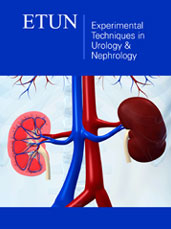- Submissions

Abstract
Experimental Techniques in Urology & Nephrology
Use of a Modified Ureteral Access Sheath (mUAS) in Semi-Rigid Ureteroscopy (URS) to Treat Large Upper Ureteral Stones is Associated with High Stone Free Rates
-
Open or Close Jad Alsmadi1, Xiaohang Li2 and Guohua Zeng3*
1 Department of Urology, Minimally Invasive Surgery Center, The First Affiliated Hospital of Guangzhou Medical University, China
2 Guangzhou Institute of Urology, China
2 Guangdong Key Laboratory of Urology, China
*Corresponding author: Guohua Zeng, Guangdong Key Laboratory of Urology, #1, kangda Road, Haizhu District, Guangzhou, Guangdong, China
Submission: August 20, 2018; Published: September 27, 2018

ISSN: 2578-0395Volume2 Issue3
Abstract
Purpose: To examine differences in outcomes of semi-rigid-ureteroscopy (URS) with or without a modified-ureteral-access-sheath (mUAS) to treat large upper ureteral stones.
Methods: Patients with single, radio-opaque large upper ureteral stone (≥10mm) treated using semi-rigid-URS between August 2013 and October 2016 were retrospectively evaluated. The stone-free (SF) status was determined from kidney-ureter-bladder-x-ray (KUB) films taken on postoperative day 1 and after 1 month.
Results: Of 103 patients meeting inclusion criteria, 43(41.75%) and 60(58.25%) were treated with semi-rigid-URS with and without mUAS, respectively. The immediate stone-free-rate (SFR) for the mUAS group was significantly higher than the non-mUAS group (40(93.0%) vs. 46(76.7%); p=0.033). The SFR at 1 month was also high for patients treated using mUAS, but not statistically different from patients not treated with mUAS (41(95.3%) mUAS vs. 51(85.0%) non-mUAS; p=0.115). Auxiliary procedure rates were significantly lower for mUAS patients compared to non-mUAS patients (4.65% vs. 23.34%, respectively; p=0.01 respectively). There were no significant differences in surgical duration and hospital stay, and the overall complication rates were statistically similar for both groups (2.3% vs. 5.0%, for mUAS and non-mUAS, respectively; p=0.638).
Conclusion: Application of mUAS to treat large upper ureteric stones was associated with higher immediate SFR and final SFR, and lower auxiliary procedure rates relative to patients treated without use of mUAS. Moreover, the use of mUAS did not lengthen operation duration or hospital stays.
Keywords: Ureteroscopy (URS); Semi-rigid; Large ureteral stones; Ureteral access sheath (UAS); Modified ureteral access sheath (mUAS)
Abbreviations: UAS/mUAS: Ureteral Access Sheath/Modified-UAS; URS: Ureteroscopy/Ureteroscope; F-URS: Flexible Ureteroscope; SFR: Stone Free Rate; KUB: Kidney-Ureter-Bladder X-Ray; NCCT: Non-Contrasted Computer Tomography Scan; US: Ultrasound; IVU: Intravenous Urography; RIRS: Retrograde Intrarenal Surgery; SWL: Shock Wave Lithotripsy; DJ: Double J Stent
 a Creative Commons Attribution 4.0 International License. Based on a work at www.crimsonpublishers.com.
Best viewed in
a Creative Commons Attribution 4.0 International License. Based on a work at www.crimsonpublishers.com.
Best viewed in 







.jpg)






























 Editorial Board Registrations
Editorial Board Registrations Submit your Article
Submit your Article Refer a Friend
Refer a Friend Advertise With Us
Advertise With Us
.jpg)






.jpg)














.bmp)
.jpg)
.png)
.jpg)










.jpg)






.png)

.png)



.png)






